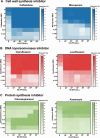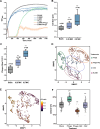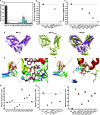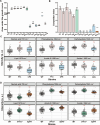Phage-antibiotic synergy suppresses resistance emergence of Klebsiella pneumoniae by altering the evolutionary fitness
- PMID: 39248568
- PMCID: PMC11481518
- DOI: 10.1128/mbio.01393-24
Phage-antibiotic synergy suppresses resistance emergence of Klebsiella pneumoniae by altering the evolutionary fitness
Abstract
Phage-antibiotic synergy (PAS) represents a superior treatment strategy for pathogen infections with less probability of resistance development. Here, we aim to understand the molecular mechanism by which PAS suppresses resistance in terms of population evolution. A novel hypervirulent Klebsiella pneumoniae (KP) phage H5 was genetically and structurally characterized. The combination of H5 and ceftazidime (CAZ) showed a robust synergistic effect in suppressing resistance emergence. Single-cell Raman analysis showed that the phage-CAZ combination suppressed bacterial metabolic activities, contrasting with the upregulation observed with phage alone. The altered population evolutionary trajectory was found to be responsible for the contrasting metabolic activities under different selective pressures, resulting in pleiotropic effects. A pre-existing wcaJ point mutation (wcaJG949A) was exclusively selected by H5, conferring a fitness advantage and up-regulated activity of carbohydrate metabolism, but also causing a trade-off between phage resistance and collateral sensitivity to CAZ. The wcaJ point mutation was counter-selected by H5-CAZ, inducing various mutations in galU that imposed evolutionary disadvantages with higher fitness costs, and suppressed carbohydrate metabolic activity. H5 and H5-CAZ treatments resulted in opposite effects on the transcriptional activity of the phosphotransferase system and the ascorbate and aldarate metabolism pathway, suggesting potential targets for phage resistance suppression. Our study reveals a novel mechanism of resistance suppression by PAS, highlighting how the complexity of bacterial adaptation to selective pressures drives treatment outcomes.
Importance: Phage-antibiotic synergy (PAS) has been recently proposed as a superior strategy for the treatment of multidrug-resistant pathogens to effectively reduce bacterial load and slow down both phage and antibiotic resistance. However, the underlying mechanisms of resistance suppression by PAS have been poorly and rarely been studied. In this study, we tried to understand how PAS suppresses the emergence of resistance using a hypervirulent Klebsiella pneumoniae (KP) strain and a novel phage H5 in combination with ceftazidime (CAZ) as a model. Our study reveals a novel mechanism by which PAS drives altered evolutionary trajectory of bacterial populations, leading to suppressed emergence of resistance. The findings advance our understanding of how PAS suppresses the emergence of resistance, and are imperative for optimizing the efficacy of phage-antibiotic therapy to further improve clinical outcomes.
Keywords: evolutionary trajectory; hypervirulent Klebsiella pneumoniae; metabolic activity; phage-antibiotic synergy.
Conflict of interest statement
The authors declare no conflict of interest.
Figures





References
-
- Magill SS, Edwards JR, Bamberg W, Beldavs ZG, Dumyati G, Kainer MA, Lynfield R, Maloney M, McAllister-Hollod L, Nadle J, Ray SM, Thompson DL, Wilson LE, Fridkin SK, Emerging Infections Program Healthcare-Associated Infections and Antimicrobial Use Prevalence Survey Team . 2014. Multistate point-prevalence survey of health care-associated infections. N Engl J Med 370:1198–1208. doi:10.1056/NEJMoa1306801 - DOI - PMC - PubMed
MeSH terms
Substances
Grants and funding
- 2021YFC2300300/MOST | National Key Research and Development Program of China (NKPs)
- JCYJ20220530152800001/Shenzhen Basic Research projects
- 2022YFE0103200/MOST | National Key Research and Development Program of China (NKPs)
- ZDBS-LY-DQC027/Chinese Academy of Sciences (CAS)
- 82102461/MOST | National Natural Science Foundation of China (NSFC)
- 22206184/MOST | National Natural Science Foundation of China (NSFC)
- 22176186/MOST | National Natural Science Foundation of China (NSFC)
- 82172330/MOST | National Natural Science Foundation of China (NSFC)
- JCYJ20200109144220704/Shenzhen Basic Research Key projects
- JCYJ20210324114213038/Shenzhen Basic Research projects
LinkOut - more resources
Full Text Sources
Other Literature Sources
Medical
Molecular Biology Databases

